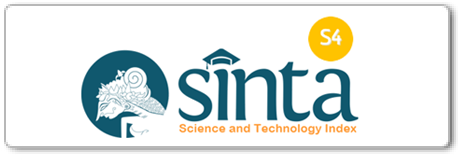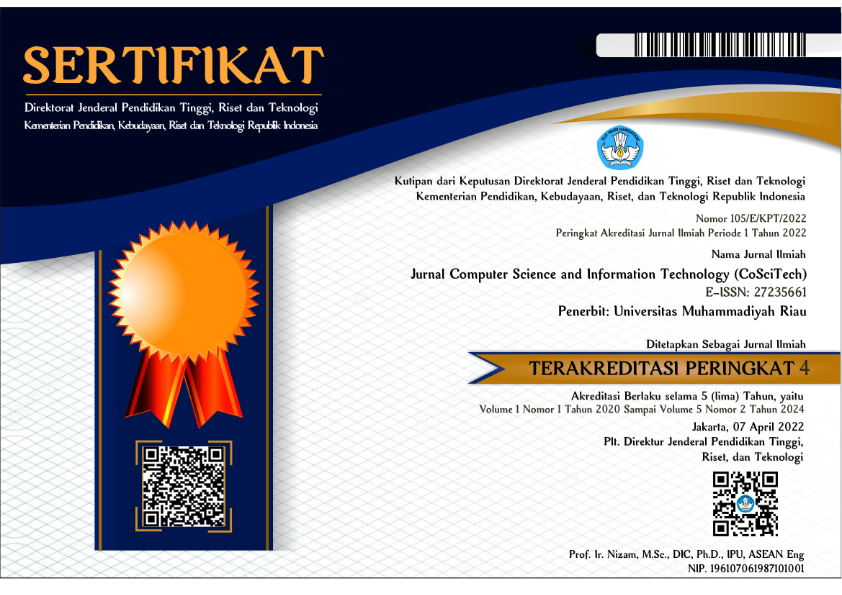Implementation of KNN and ANN to the classification of the nutritional status of toddlers based on anthropometric indices
DOI:
 https://doi.org/10.37859/coscitech.v4i2.5079
https://doi.org/10.37859/coscitech.v4i2.5079
Abstract
Health problems related to nutritional status is still a big deal in Indonesia. Data from the survey on the nutritional status of toddlers in Indonesia (SSGBI) in 2021 shows that the prevalence of stunting in Indonesia has reached 24.4%, wasted has reached 7.1%, and underweight reaching 17.0%. The number of toddlers suffering from stunting in Indonesia still exceeds the threshold set by WHO, which is 20%. Even though it is decreasing every year, the problem of malnutrition in Indonesia is still high. Therefore, recording and grouping nutrition under five to determine the growth and development and nutrition of children under five in order to reduce the level of malnutrition becomes very important. One way to group data is by classification. In this study the algorithm used is the K-Nearest Neighbor (KNN) and Artificial Neural Network algorithms. The K-Nearest Neighbors (KNN) algorithm is an algorithm for classifying based on the proximity of a data location (distance) to other data. Meanwhile, the ANN algorithm is a computational system algorithm where the architecture and operations are inspired by knowledge of biological nerve cells in the brain. Assessment of the nutritional status of toddlers can be measured based on anthropometric measurements consisting of the variables age, sex, weight (BB) and height (TB). The results showed the ANN algorithm, k-NN with k = 3 on the BB/U, BB/TB, and TB/U dataset, k-NN with k = 5 on the TB/U dataset, k-NN with k = 7 on the dataset TB/U has the most optimum accuracy value (99%) with a small error value (0.007). The model is saved and loaded into a web app with 3 nutritional status categories, namely Weight/Age, Weight/Height, and Height/Age.
Downloads
References
[2] Dinas Kesehatan, “Jumlah Balita Berdasarkan Kategori Balita Gizi Buruk di Jawa Barat,” https://opendata.jabarprov.go.id/, 2019. https://opendata.jabarprov.go.id/id/dataset/jumlah-balita-berdasarkan-kategori-balita-gizi-buruk-di-jawa-barat (accessed Jan. 04, 2023).
[3] “Buletin-1IND_1000HPK_2013-10-03”.
[4] J. Kesehatan, R. F. Putri, D. Sulastri, and Y. Lestari, “Faktor-Faktor yang Berhubungan dengan Status Gizi Anak Balita di Wilayah Kerja Puskesmas Nanggalo Padang,” 2015. [Online]. Available: http://jurnal.
[5] L. C. Chikhungu, N. J. Madise, and S. S. Padmadas, “How important are community characteristics in influencing children’s nutritional status? Evidence from Malawi population-based household and community surveys,” Health Place, vol. 30, pp. 187–195, Nov. 2014, doi: 10.1016/j.healthplace.2014.09.006.
[6] E. Triwira Lestari and J. Adhiva, “SENTIMAS: Seminar Nasional Penelitian dan Pengabdian Masyarakat Implementation Naive Bayes Classifier Algorithm and K-Nearest Neighbor For Obesity Nutritional Status of Children with Disabilities Implementasi Algoritma Naive Bayes Classifier dan K-Nearest Neighbor Untuk Klasifiasi Status Gizi Obesitas Anak Disabilitas”, [Online]. Available: https://journal.irpi.or.id/index.php/sentimas
[7] E. Rolimarch Pratama and J. B. B. Darmawan, “KLASIFIKASI STATUS GIZI BALITA MENGGUNAKAN JARINGAN SYARAF TIRUAN BACKPROPAGATION,” 2021.
[8] G. P. Insany, M. A. Ayu and T. Mantoro, "Using Machine Learning Techniques and Wi-Fi Signal Strength for Determining Indoor User Location," 2021 IEEE 7th International Conference on Computing, Engineering and Design (ICCED), Sukabumi, Indonesia, 2021, pp. 1-5, doi: 10.1109/ICCED53389.2021.9664859.














